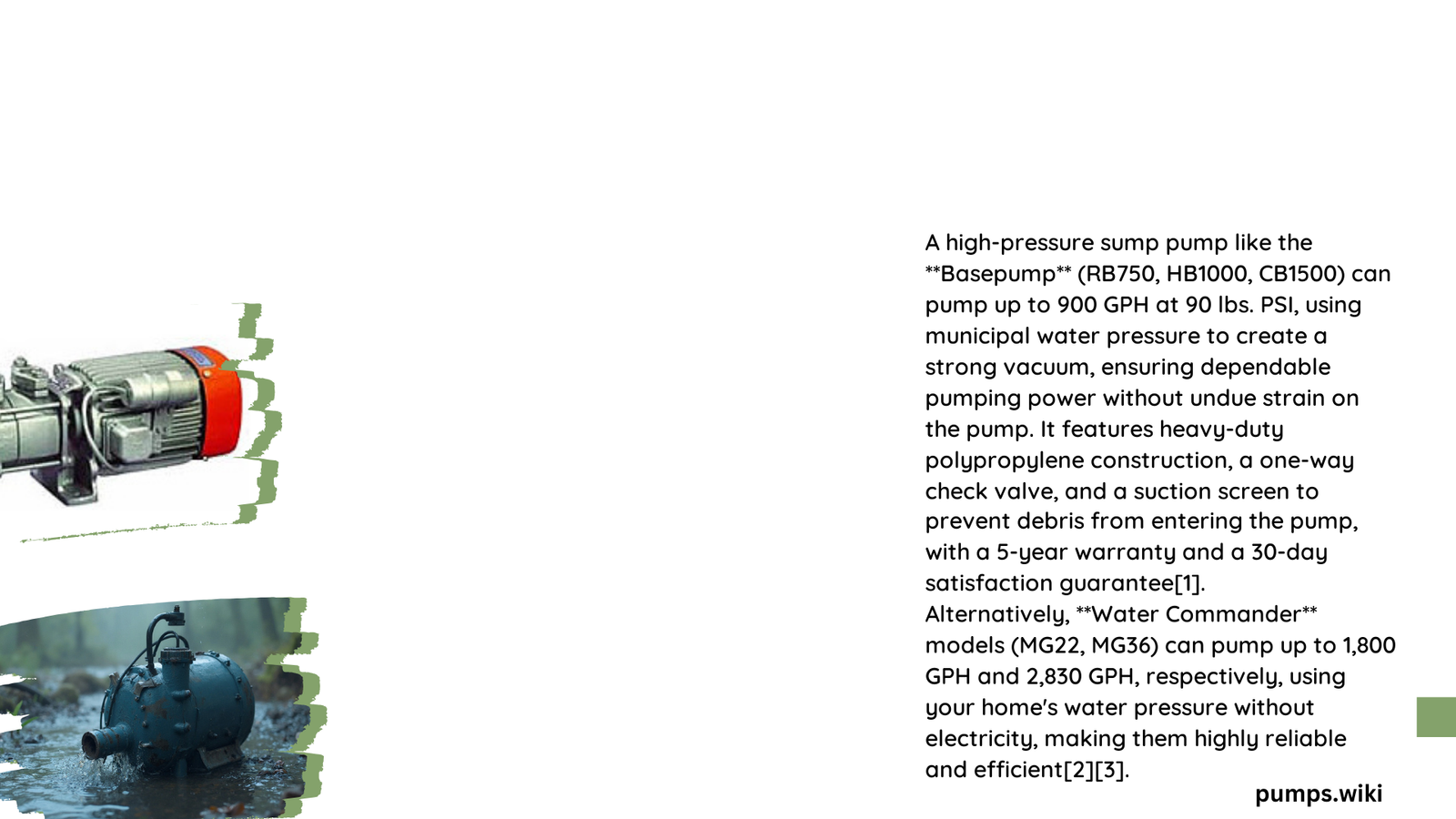High pressure sump pumps are essential for protecting basements from flooding in areas with high water tables or frequent heavy rainfall. These pumps are designed to move large volumes of water quickly and efficiently, with the ability to pump water to greater heights than standard sump pumps. High pressure sump pumps typically feature robust construction, powerful motors, and advanced impeller designs to handle demanding drainage situations.
What Are the Key Features of High Pressure Sump Pumps?
High pressure sump pumps are characterized by their ability to move water at higher pressures and to greater heights than standard sump pumps. Key features include:
- Higher horsepower motors (typically 1/3 HP to 2 HP or more)
- Greater maximum head heights (often 20 feet or more)
- Higher flow rates (measured in gallons per minute or GPM)
- Durable construction materials like cast iron or aluminum
- Advanced impeller designs for efficient water movement
- Thermal overload protection to prevent motor burnout
How Do High Pressure Sump Pumps Compare to Standard Models?

High pressure sump pumps offer several advantages over standard models:
| Feature | High Pressure Sump Pump | Standard Sump Pump |
|---|---|---|
| Horsepower | 1/3 HP to 2+ HP | 1/4 HP to 1/2 HP |
| Max Head Height | 20+ feet | 10-15 feet |
| Flow Rate | 40+ GPM | 20-30 GPM |
| Construction | Cast iron, aluminum | Plastic, light-duty metals |
| Price | $200-$700+ | $50-$200 |
What Are the Best High Pressure Sump Pumps for Basements?
When selecting a high pressure sump pump for your basement, consider these top-performing models:
- Barmesa Submersible Sump Pump – 2AHS203
- 2.0 HP motor
- 134 GPM flow rate
- 81 feet maximum head height
-
Cast iron construction
-
Liberty 230-Series 1/3 HP Aluminum Submersible Sump Pump
- 1/3 HP motor
- 44 GPM flow rate at maximum head
- 21 feet maximum head height
-
Aluminum construction with vortex impeller
-
Little Giant 6 Series Sump Pump
- 1/3 HP motor
- 46 GPM flow rate at 5 feet of head
- 18 feet maximum head height
- Epoxy-coated cast iron or bronze construction
How to Install a High Pressure Sump Pump?
Installing a high pressure sump pump requires careful planning and execution. Follow these steps:
- Prepare the sump pit
- Position the pump in the pit
- Connect the discharge pipe and check valve
- Install the float switch
- Connect the power supply
- Test the pump operation
Ensure you have the necessary tools and materials before beginning the installation process.
What Are Common Challenges in High Pressure Sump Pump Installation?
During installation, you may encounter several challenges:
- Incorrect sump pit size: Ensure your pit meets the manufacturer’s specifications.
- Improper discharge pipe installation: Use the correct pipe diameter and avoid sharp bends.
- Electrical issues: Always use a GFCI-protected outlet and follow local electrical codes.
- Float switch adjustment: Properly set the on/off levels to prevent short cycling.
How to Maintain a High Pressure Sump Pump?
Regular maintenance is crucial for optimal performance:
- Clean the pump and pit quarterly
- Test the pump operation monthly
- Inspect and clean the check valve annually
- Replace the battery backup (if applicable) every 2-3 years
- Schedule professional inspections every 1-2 years
What Are the Pros and Cons of High Pressure Sump Pumps?
Pros:
- Higher pumping capacity
- Greater maximum head height
- More durable construction
- Better suited for demanding drainage situations
Cons:
- Higher initial cost
- Increased power consumption
- May require professional installation
- Potentially louder operation
How to Choose the Right High Pressure Sump Pump for Your Needs?
Consider these factors when selecting a high pressure sump pump:
- Basement size and water table level
- Required flow rate and head height
- Power source availability (single-phase vs. three-phase)
- Budget constraints
- Noise tolerance
- Backup power requirements
What Are User Experiences with High Pressure Sump Pumps?
Users generally report positive experiences with high pressure sump pumps, citing:
- Improved peace of mind during heavy rainfall
- Ability to handle larger volumes of water
- Longer lifespan compared to standard pumps
- Reduced frequency of pump cycling
However, some users note higher electricity costs and increased noise levels as potential drawbacks.
How Do High Pressure Sump Pumps Perform in Emergency Situations?
High pressure sump pumps excel in emergency situations due to their:
- Higher pumping capacity
- Ability to move water over greater distances
- Robust construction that can handle debris
- Thermal overload protection for extended operation
Many models also offer battery backup options for continued operation during power outages.
By understanding the capabilities, installation requirements, and maintenance needs of high pressure sump pumps, homeowners can make informed decisions to protect their basements from water damage effectively.
References:
1. https://www.absolutewaterpumps.com/barmesa-submersible-sump-pump-2ahs203-2-134-gpm-2-hp-3-phase-cast-iron
2. https://amtpumps.com/site/product/industrial-sump-pumps/
3. https://www.septicsolutions.com/septic-parts/submersible-pumps/sump-pumps/237_liberty-230-series-13-hp-aluminum-submersible-sump-pump
